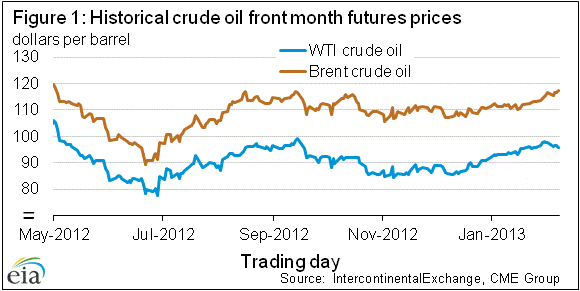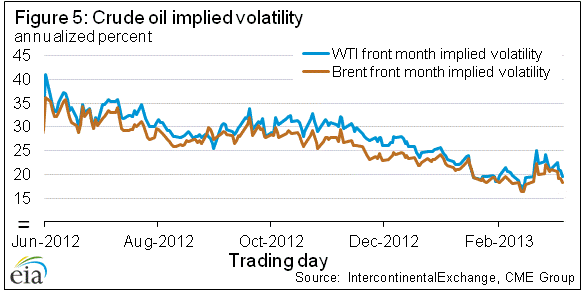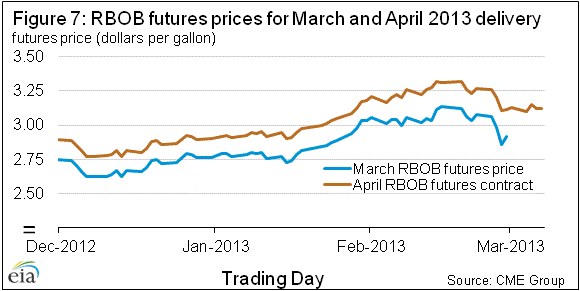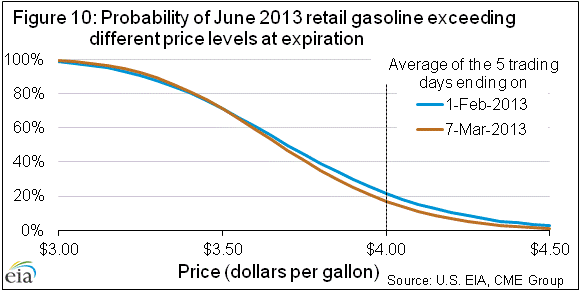Short-Term Energy Outlook
Release Date: February 12, 2013 | Next Release Date: March 12, 2013 | Full Report | Text Only | All Tables | All Figures
Market Prices and Uncertainty Report
This is a regular monthly supplement to the EIA Short-Term Energy Outlook.
Contact: James Preciado (James.Preciado@eia.gov)
Full Report
Crude Oil
Prices: Crude oil prices moved higher in January and out of the trading range they had been in for much of fourth quarter 2012 (Figure 1). The Brent front month futures contract averaged $112.35 per barrel in January, an increase of about $3 per barrel from its December average, and denoted the highest monthly average for the crude oil benchmark since September 2012. West Texas Intermediate (WTI) crude oil front month futures prices also increased in January, averaging $94.83 per barrel. Prices also continued to move higher in early February.
January saw a broad-based rally in most commodity and equity markets around the world. Contributors to the increase in oil prices included bullish economic data for the U.S. housing market, upbeat corporate earnings report, and reaffirmation by the Federal Reserve of its commitment to an open-ended bond-buying program, also known as quantitative easing. On the supply side, Saudi Arabia lowered production of crude oil from 9.8 million barrels per day in September 2012 to an estimated 9.1 million barrels per day in January 2013.
The Brent-WTI price spread moved lower in the first half of January and settled at a 7 month low of $15.61 per barrel on January 17 (Figure 2). The decrease in the spread was due to increased volumes of crude oil being moved by pipeline from Cushing, Oklahoma, to refineries on the U.S. Gulf Coast through the recent Seaway Pipeline expansion. However, on January 23, Seaway operators announced that the pipeline will run at reduced capacity until the third or fourth quarter of this year while additional infrastructure is built to alleviate a crude oil bottleneck at one of the pipeline terminals. Subsequently, the Brent-WTI spread increased to settle at $21.41 per barrel on February 7.
Despite the recent volatility in the front month Brent-WTI spread, longer-dated spreads between these two crude oil benchmarks have been relatively stable. The difference between the December 2015 Brent and WTI futures contracts has remained between $7.00 per barrel and $8.50 per barrel since early December 2012. Recent changes in expectations for near-term crude oil transportation infrastructure appear not to have had an effect on the market's expectation for the long-term differential between Brent and WTI prices.
Equities: The January 2 to February 7 averages of the S&P 500 (a broad measure of the U.S. stock market) and the Hang Seng index (an index of stocks for Chinese companies that trades in Hong Kong) increased by 4.5 percent and 4.4 percent, respectively, compared to their December averages. The average prices of the front month contract for Brent increased by 3.6 percent in the same period (Figure 3). The United States and China are the first and second largest consumers of petroleum products in the world and expectations for economic growth in these two countries are two of the main drivers of crude oil prices. Generally, major stock indexes are highly correlated with expectations for economic growth and can give a real-time indication of the market's opinion of whether prospects for economic growth are either increasing or decreasing. Oil prices can also be affected by reports on production and other supply side information, but the correlation between oil prices and equity markets has remained strong for the past several years.
United States employment: On the first Friday of every month, the Bureau of Labor Statistics releases a report detailing the number of jobs the U.S. economy created in the previous month. It is one of the most watched economic indicators and often sets a market tone over the next month for expected economic growth. In the first quarter of 2012, the U.S. economy added an average 262,000 jobs per month. At the same time, crude oil prices increased to their highest point during the year and averaged more than $118 per barrel (Figure 4)1. When job growth slowed in the middle of the year, Brent crude oil prices hit their lowest levels of the year. Over the last three months, the U.S. economy has added 200,000 jobs per month and Brent crude oil prices have moved in the range of $105 to $115 per barrel.
Volatility: Implied volatility for both Brent and WTI moved lower in January. Implied volatility for options on front month Brent and WTI futures contracts settled at 18.6 and 20.3 percent, respectively, on February 7 (Figure 5). In fact, implied volatity for WTI settled at its lowest point in more than five years on January 31. Low implied volatility makes call and put options less expensive when using them to hedge against or speculate for crude oil price movements.
Market Derived Probabilities: The May 2013 WTI futures contract averaged $97.55 per barrel for the five trading days ending February 7 and has a probability of exceeding $100 per barrel at expiration of approximately 38 percent. The same contract for the five trading days ending January 2 had a probability of exceeding $100 of 29 percent. An increase in crude oil prices more than offset lower implied volatility and less time to expiration and resulted in increased probabilities to exceed higher prices (Figure 6). Give the elevated price of Brent relative to WTI, the probability of Brent futures contracts expiring above different dollar thresholds is higher.
Gasoline
Prices: Front month futures prices for Reformulated Blendstock for Oxygenate Blending (RBOB) gasoline for delivery in New York Harbor settled at $3.00 per gallon on February 7, an increase of $0.20 per gallon from January 2 (Figure 7). Aside from the brief price spike that occurred at expiration of the October futures contract at the end of September, the February 6 settle price of $3.04 per gallon marked the highest settlement price for the front month RBOB contract since September 11, 2012. January also saw an increase in the RBOB-Brent crack spread, which settled at $0.21 per gallon on February 7.
The increase in the crack spread suggests that the recent upward movement in gasoline prices reflected refinery developments as well as increases in crude oil prices. U.S. refineries hit a utilization rate of over 90 percent for the four-week period ending December 28. After sustaining that level of production, it is normal to see utilization rates drop for planned maintenance and they are now at a utilization of 85.2 percent for the four-week average ending February 1. The unexpected outage of the Stanlow refinery in the United Kingdom has also contributed to recent tightness in the Atlantic Basin gasoline market.
Volatility: Both implied volatility and historical volatility for the front month RBOB futures contract declined over the last month. Implied volatility settled at 19.3 percent on February 7, a decline of 3.4 percentage points since January 2 (Figure 8). Over the same period, historical volatility moved lower by 1.8 percentage points to settle at 17.9 percent on February 7.
Market Derived Probabilities: The May 2013 RBOB futures contract averaged $3.17 per gallon for the five trading days ending February 7 and has a probability of exceeding $3.10 per gallon (typically leading to a retail price of $3.75) at expiration of approximately 57 percent. The same contract for the five trading days ending January 2 had a probability of exceeding $3.10 of 29 percent. The higher RBOB futures prices were the main reason for the increase in exceeding higher prices by expiration of the May futures contract (Figure 9).
Heating Oil
Prices: The front month heating oil futures contract settled at $3.20 per gallon on February 7, an increase of 0.15 per gallon from January 2. The front month futures crack spread between heating oil and Brent settled at $0.41 per gallon on February 7, nearly unchanged from early January (Figure 10).
In contrast to gasoline prices, the recent rise in heating oil prices was mostly due to increases in crude oil prices. The heating oil-Brent crack spread has remained relatively constant at robust levels over the last month, and the recent reduction in U.S. refinery utilization and increased refinery outages have not had a major impact on distillate prices.
Volatility: Heating oil historical volatility and implied volatility both decreased from early January to the first week in February (Figure 11). Historical realized 30-day volatility was 13.6 percent on February 7, a decline of 4.5 percentage points since January 2, while implied volatility settled at 16.3 percent on February 7, a fall of 4.0 percentage point from January 2.
Market Derived Probabilities: The May 2013 heating oil futures contract averaged $3.19 per gallon for the five trading days ending February 7 and has a probability of exceeding $3.25 per gallon at expiration of approximately 40 percent. The same contract for the five trading days ending January 2 had a probability of exceeding $3.25 of 27 percent (Figure 12).
Natural Gas
Prices: The front month futures price settled at $3.29 per MMBtu on February 7, increasing $0.05 per MMBtu from the price on January 2 (Figure 13). Colder weather provided support for a brief rise in prices in mid-January and, despite recent declines, prices remain higher than at the beginning of January.
New England Basis: The most notable development in natural gas markets during January was the very high prices in the northeast during cold weather in the middle of the month. The New England basis, or the difference of spot prices between New England and Louisiana's Henry Hub, was sharply higher during the recent cold weather. On January 25, the spot price in New England was $31.10 per MMBtu higher than the Henry Hub price (Figure 14).
Pipelines from the south and west provide the primary supply to New England, with LNG providing marginal supply. During times of high demand, higher prices tend to trigger greater LNG flows (see STEO Supplement), without which prices would rise even further.
Volatility: Implied volatility for the front month futures contract declined in January, settling at 32.9 percent on February 7, 4.0 percentage points lower than at the beginning of January. In contrast, historical volatility rose slightly during the month of January, settling at 38.4 percent on February 7, 0.5 percentage points higher than at the beginning of January (Figure 15).
Market Derived Probabilities: The probability that the May 2013 contract will settle higher than $4.00 per MMBtu declined by 7 percentage points from 21 percent to 14 percent when compared to market conditions on the five trading days ending January 2 (Figure 16). Lower volatility was the main cause for the drop in the proability of exceeding higher price levels by the expiration of the May 2013 futures contract.
1 This graph shows the number of jobs created the previous month for which the bars correspond. For example, the April bar on this graph is the number of jobs that were created in March and paired against the April Brent crude oil average. At the beginning of each month, the Bureau of Labor Statistics reports the number of jobs the economy created the previous month. Since markets are forward looking, job creation for the previous month is often used as a barometer for expected job creation in the next month, and thus a proxy for expectations of economic growth. This is why the best comparison is the previous month's job creation with the current month Brent price.
Other Resources
Energy Price Volatility and Forecast Uncertainty documentation
(Adobe PDF file)
West Texas Intermediate crude oil price and NYMEX 95% confidence intervals
January 2011 - Current Month
(Adobe PDF file)
January 2009 - December 2010
(Adobe PDF file)
January 2007 - December 2008
(Adobe PDF file)
Henry Hub natural gas price and NYMEX 95% confidence intervals
January 2011 - Current Month
(Adobe PDF file)
January 2009 - December 2010
(Adobe PDF file)
January 2007 - December 2008
(Adobe PDF file)
















